Evolution towards Coordinated Multi-Point Architecture in Self-Organizing Networks for Small Cell Enhancement Systems
Abstract
:1. Introduction
2. Design Rules of Small Cell Enhancement Systems
2.1. Basic Theory
2.2. Channelization of Link Budget
2.2.1. Path Loss
- df > D, df > λ.
- d > d0 > df.
2.2.2. Link Budget between eNB and Cellular Phone
- Determine the sensitivity of eNB and cellular phone:SeNB = (−120 dBm) + 10 dB + 9 dB = −101 dBm.Scellular phone = (−121 dBm) + 12 dB + 9 dB = −100 dBm.
- Find the maximum radio frequency uplink path loss signal, PLUL,max:PLUL,max = POcellular phone − SeNB = 30 dBm − (−101 dBm) = 131 dB.
- Find the maximum radio frequency downlink path loss signal, PLDL,max:PLDL,max = POeNB − Scellular phone = 44 dBm − (−102 dBm) = 146 dB.
- Find the highest path loss discrepancy of the bi-direction imbalance, Imb:Imb = PLDL,max − PLUL,max = 146 dB − 131 dB = 15 dB.
3. Research of the Key Elements
3.1. Calculating Gain of Fiber Optical Repeater
3.2. Injection of eNB Deviation by Fiber Optical Repeater
- Case 1: When NFrep − NFeNB + Grep − Lp = 0, by ΔNeNB, the noise floor has increased to 3 dB, in the receiver terminal of eNB.
- Case 2: When NFrep − NFeNB + Grep − Lp = −6, by ΔNeNB, the noise floor has increased to 0.97 dB, in the receiver terminal of eNB.
- Therefore, in this case, the injected fiber optical repeater does not have an influence on the eNB receiver. Usually, the noise figure of eNB, NFeNB = 2 dB. According to Equation (10), the eNB noise power injected by the fiber optical repeater is Prep = −125 dBm.
- The path loss Lp from eNB transmitter to fiber optical repeater.
- The number of fiber optical repeater in parallel to eNB receivers.
3.3. Calculation of Equilibrium between Fiber Optical Repeater and Cellular Phone
- Repeater absolute delay time, Td-Rep, is 6–8 μs.
- Coaxial cable delay time, Td-Coax, is D/0.88 × C.
- Optic fiber delay time, Td-Opt, is D/0.66 × C.
- (1)
- One signal arrives directly from the eNB while the other is retransmitted via optical equipment. This can be expressed as Equations (15) and (16):
- (2)
- Two signals have been retransmitted from two different fiber optic RUs, as shown in Figure 9.
4. Solution of the Fiber Optical Repeater
4.1. System Infrastructure and Link Budget
4.1.1. Indoor Coverage Requirements and Inspection Methods
4.1.2. Link Budget and Novel System Network Structure
4.1.3. An Add-on Solution Consisting of a New 5G FR on the Empty Side
4.1.4. Calculations of the Power Spectrum Density
- Handover parameters are optimized by identifying three handover scenarios: too early, too late, and ping-pong.
- Parameters are adjusted according to handover statistics.
- Evaluation of adjustment and punishment is supported.
- MRO automatically resolves handover failures and optimizes mobility in a radio network.
- Customer experience is improved by reducing drop call rate and handover failure rate.
- Operators are assisted to optimize mobility by saving resources.
- Cell-edge performance, cell-center performance, intra- and inter-cell interference, and mobility load balancing distribution factors.
- Antenna tilt, enhanced tilt, and total power.
4.1.5. R4/4A Stations Power Spectrum Density
- R4 Station body: At 195 m, R4 station eNB provides signals covering the tunnel from R4 to R4A. The machine control room to subway tunnel exit are 183 m, 1-7/8″, coaxial cable loss is 7 dB, and the subway tunnel length is 1800 m.
- Intersection: Fiber optical repeaters are installed for two RUs (one each in the south and north tunnels). The POI output terminal connects to the MU, while the MU output terminals connect the fiber cable to the intersection RU input terminal.
- A 1-7/8″ leakage coaxial cable is placed on the upper edge of the wall surface of the third track in the R4 to R4A south/north tunnel, and the leakage coaxial cable is connected to the output port of the RU.
4.1.6. R4/4A in Subway Tunnel for Traffic Data Signal Coverage Canalization
- R4 subway tunnel entrance to tunnel, R4A subway tunnel entrance to tunnel, and Point Of Interconnection + 1-7/8″ leakage coaxial cable:
- Interconnection exit to R4 tunnel and interconnection exit to R4A tunnel:
4.2. Measurement of Practice
4.2.1. System Structure and Cell Coverage Plan
4.2.2. Measurement Tools
4.2.3. Results of Measurement
- Station and platform
- Tunnel
- Train tracking was carried out twice in both directions for the MLB and MRO function of each system.
- Smooth signal handoff in the tunnel was observed, with there being no decline in call rate in the case of signal intensity.
5. Conclusions
Author Contributions
Funding
Data Availability Statement
Acknowledgments
Conflicts of Interest
References
- JOINT NGMN/WBA RAN CONVERGENCE PAPER 2019. pp. 10–16. Available online: https://ngmn.org/wp-content/uploads/Publications/2019/190903-RAN-Convergence-Paper (accessed on 1 April 2023).
- 3rd Generation Partnership Project (3GPP). TR 36.742. Study on Self-Organizing Networks (SON) for Enhanced Coordinated Multi-Point (eCoMP) (Rel-15), Version 15.0.0. 2017. Available online: https://portal.3gpp.org/desktopmodules/Specifications/SpecificationDetails.aspx?specificationId=3084 (accessed on 1 April 2023).
- 3rd Generation Partnership Project (3GPP). TR36.746 Study on Further Enhancements to LTE Device to Device (D2D), UE to Network Relays for IoT (Internet of Things) and Wearables, V2.0.1. October 2017. Available online: http://www.3gpp.org/ftp//Specs/archive/36_series/36.746/36746-201.zip (accessed on 27 December 2017).
- 3rd Generation Partnership Project (3GPP). TR36.897 Study on Further Enhancements to LTE Device to Device (D2D), UE to Network Relays for Internet of Things (IoT) and Wearables, V.d.0.0. July 2015. Available online: https://www.3gpp.org/ftp/Specs/archive/36_series/36.897/36897-d00.zip (accessed on 3 July 2015).
- 3rd Generation Partnership Project (3GPP). TR36.897 Evolved Universal Terrestrial Radio Access (E-UTRA); LTE Advanced inter-band Carrier Aggregation (CA) Rel-15 for 5 Down Link (DL)/1 Up Link (UL) and Wearables, V.f.0.0. July 2018. Available online: https://www.3gpp.org/ftp/Specs/archive/36_series/36.715-05-01/36715-05-05-f00.zip (accessed on 12 July 2018).
- Koshy, B.J.; Shankar, P.M. Spread-Spectrum Techniques for Fiber-Fed Micro-cellular Networks. IEEE Trans. Veh. Technol. 1999, 48, 847–857. [Google Scholar] [CrossRef]
- Prasad, M.V.S.N.; Singh, R. Terrestrial mobile communications train measurements in Western India. IEEE Trans. Veh. Technol. 2003, 52, 671–682. [Google Scholar] [CrossRef]
- Briso-Rodríguez, C.; Cruz, J.M.; Alonso, J.I. Measurements and Modeling of Distributed Antenna Systems in Railway Tunnels. IEEE Trans. Veh. Technol. 2007, 56, 2870–2879. [Google Scholar] [CrossRef]
- Zhang, Y.P. Practical performance of digital cellular system in mass rapid transit environments. Int. J. Commun. Syst. 2004, 18, 143–157. [Google Scholar] [CrossRef]
- Raweshidy, H.A.; Komaki, S. Radio over Fiber Technologies for Mobile Communications Networks; Artech House: Norwood, MA, USA, 2002; pp. 183–214. [Google Scholar]
- Hwang, S.T.; Kim, B.G.; Lee, S.K.; Lee, J.H.; Kim, H.L.; Lee, Y.G.; Kim, G.W. ROF technologies for in-building wireless systems. IEICE Trans. Electron. 2012, 90, 345–350. [Google Scholar] [CrossRef]
- Alcatel-Lucent Company. From Macro to Small Cells: Enhancements for Small Cells in 3GPP TSG RAN WG1; Small Cells Summit: London, UK, 2013; Available online: https://dokumen.tips/download/link/enhancements-for-small-cells-in-3gpp-release-12.html (accessed on 1 April 2023).
- 3rd Generation Partnership Project (3GPP). TR36.819 Coordinated Multi-Point Operation for LTE Physical Layer Aspects; (CA) Rel-11, V.b.2.0. Sep. 2013. Available online: https://www.3gpp.org/ftp/Specs/archive/36_series/36.819/36819-b20.zip (accessed on 18 September 2013).
- Andrew Company. ION-M85/18/21 System Overview; Worldwide Headquarters: 3 Westbrook Corporate Center Suite 900/1800/2100/2300; Andrew Company: Westchester, IL, USA, 2016. [Google Scholar]
- 3rd Generation Partnership Project (3GPP). TS 25.143 Radio Access Network UTRA Repeater Conformance Testing (Rel-6), Version 6.4.0. Available online: https://www.3gpp.org/ftp/Specs/archive/25_series/25.143/b20.zip (accessed on 4 April 2022).
- Rappaport, T.S. Wireless Communication Principles and Practice; Prentice Hall: Hoboken, NJ, USA, 1996; Volume 2, pp. 300–320. [Google Scholar]
- Goodman, J.W. Introduction to Fourier Optics, 3rd ed.; Roberts & Company Publishers: Greenwood Village, CO, USA, 2004; p. 37. [Google Scholar]
- Su, S.F. The UMTS Air-Interface in RF Engineering: Design and Operation of UMTS Networks; McGraw Hill Professional: New York, NY, USA, 2007; pp. 317–319. [Google Scholar]
- Ericsson Telecommunication, S.P.A. Cell Planning Guideline for Tunnel Coverage; TEI/CC/P-99:0062 Rev A; Telefonaktiebolaget LM Ericsson: Stockholm, Sweden, 2023; pp. 18–22. [Google Scholar]
- 3rd Generation Partnership Project (3GPP). TR 25.942 Radio Access Networks Radio Frequency (RF) System Scenarios; (Rel-1999), Version h.0.0. Available online: https://www.3gpp.org/ftp/Specs/archive/25_series/25.942/h00.zip (accessed on 4 April 2022).
- Didascalou, D.; Maüer, J.; Wiesbeck, W. Subway tunnel guided electromagnetic wave propagation at mobile communications frequencies. IEEE Trans. Antennas Propag. 2001, 49, 1590–1596. [Google Scholar] [CrossRef]
- Lienard, M.; Degauque, P. Propagation in wide tunnels at 2 GHz: A statistical analysis. IEEE Trans. Veh. Technol. 1998, 47, 1322–1328. [Google Scholar] [CrossRef]
- Andrew Company. ION-M85/18/21 Design Principle; Worldwide Headquarters: 3 Westbrook Corporate Center Suite 900/1800/2100/2300; Andrew Company: Westchester, IL, USA, 2017. [Google Scholar]
- Persson, K.A.; Alping, A.; Wake, D. WCDMA radio-over-fiber transmission experiment using electro-absorption transceiver. Electron. Lett. 2005, 41, 512–514. [Google Scholar] [CrossRef]
- Mariage, P.; Lienard, M.; Degauque, P. Theoretical and experimental approach of the propagation of high frequency waves in road tunnels. IEEE Trans. Antennas Propag. 1994, 42, 75–81. [Google Scholar] [CrossRef]
- Holloway, C.L.; Hill, D.A.; Dalke, R.A.; Hufford, G.A. Radio wave propagation characteristics in lossy circular waveguides such as tunnels, mine shafts and boreholes. IEEE Trans. Antennas Propag. 2000, 48, 1354–1366. [Google Scholar] [CrossRef]
- 3GPP RP-122009; Study on LTE Device to Device Proximity. 2012. Available online: https://portal.3gpp.org/desktopmodules/Specifications/SpecificationDetails.aspx?specificationId=2544 (accessed on 1 April 2023).
- Cox, C.H. Analog Optical Links Theory and Practice; Cambridge University Press: Cambridge, UK, 2000; pp. 159–200. [Google Scholar]
- Ericsson Review. Signal Strength measurement in LTE TEMS Mobiles. 284 23-3026 Uen Rev AB, Taiwan; Telefonaktiebolaget LM Ericsson: Stockholm, Sweden, 2021; pp. 1–45. [Google Scholar]
- 3GPP TS 25.106. V6.4.0. Radio Access Network UTRA Repeater Radio Transmission and Reception (Release 15). 2016. Available online: https://portal.3gpp.org/desktopmodules/Specifications/SpecificationDetails.aspx?specificationId=1156 (accessed on 4 April 2022).
- 3rd Generation Partnership Project (3GPP). TR36.842 Study on Small Cell Enhancements for E-UTRA and E-UTRAN—Higher Layer Aspects; (Rel-12) Version c.0.0. Available online: https://www.3gpp.org/ftp/Specs/archive/36_series/36.842/36842/c00.zip (accessed on 7 January 2014).
- Isotalo, T.; Niemela, J.; Lempiainen, J. Measurements for Distributed Antennas in WCDMA Indoor Network. January 2008, pp. 1–5. Available online: https://trepo.tuni.fi/handle/10024/128736 (accessed on 1 April 2023).
- Ericsson Review. Summary of Downlink Performance Evaluation; 3GPP TSG RAN R1-072444; Technical Report; Telefonaktiebolaget LM Ericsson: Stockholm, Sweden, 2021. [Google Scholar]
- Furuskar, A.; Almgren, M.; Johansson, K. An infrastructure cost evaluation of single and multi-access networks with heterogeneous traffic density. In Proceedings of the Vehicular Technology Conference, Stockholm, Sweden, 30 May–1 June 2005. [Google Scholar]
- Guo, W.; O’Farrell, T. Relay Deployment in Cellular Networks: Planning and Optimization. IEEE J. Sel. Areas Commun. 2012, 31, 1597–1606. [Google Scholar] [CrossRef]
- Holland, O.; Friderikos, V.; Aghvami, A.H. Energy efficient cross band spectrum management for mobile operators. In Proceedings of the Global Communications Conference, Miami, FL, USA, 6–10 December 2010; pp. 202–204. [Google Scholar] [CrossRef]
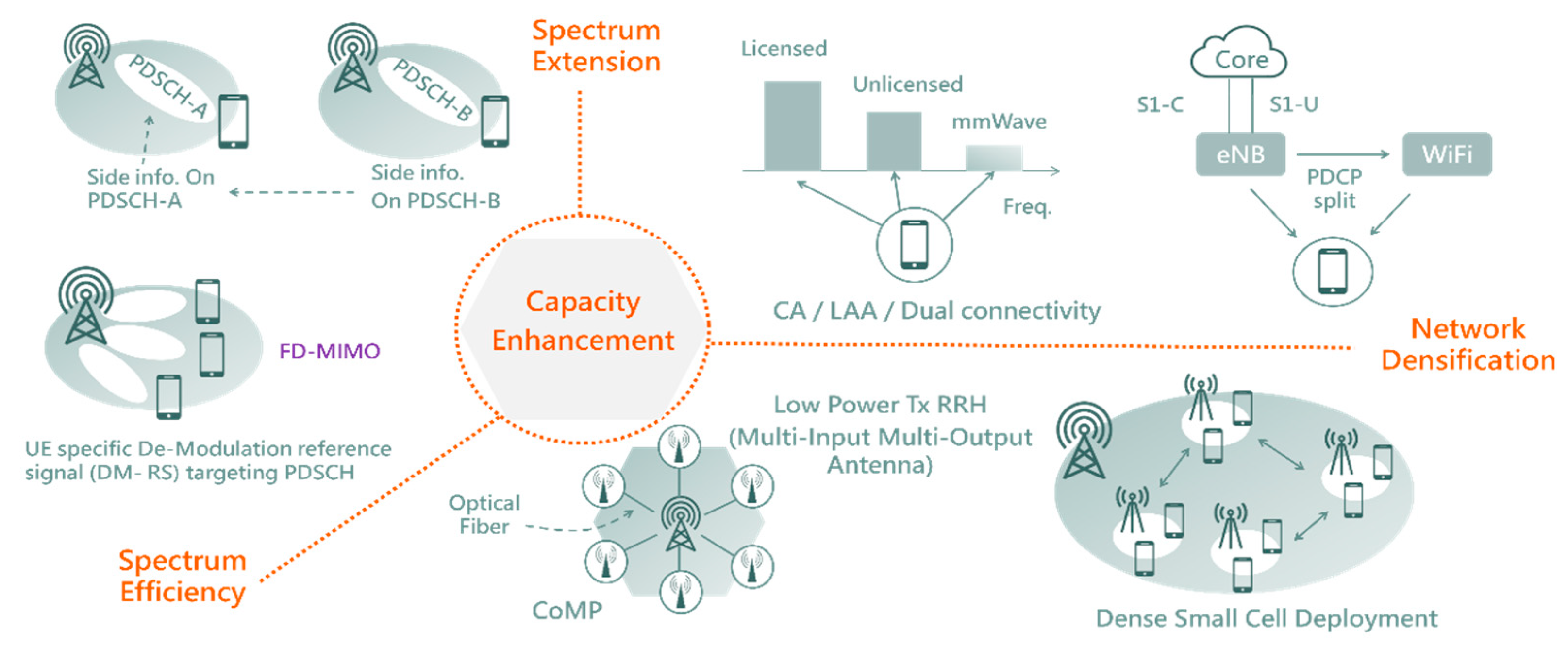
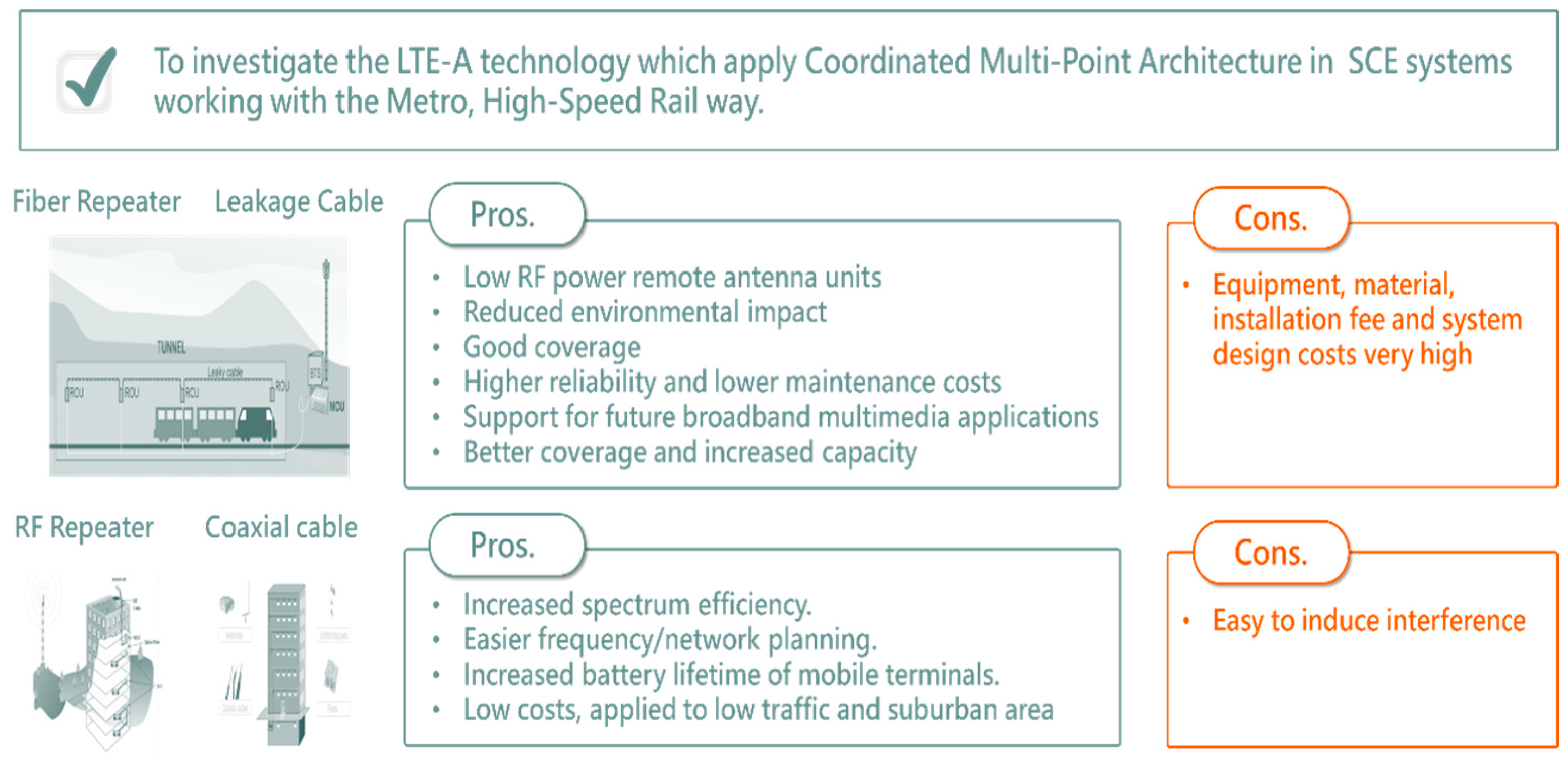

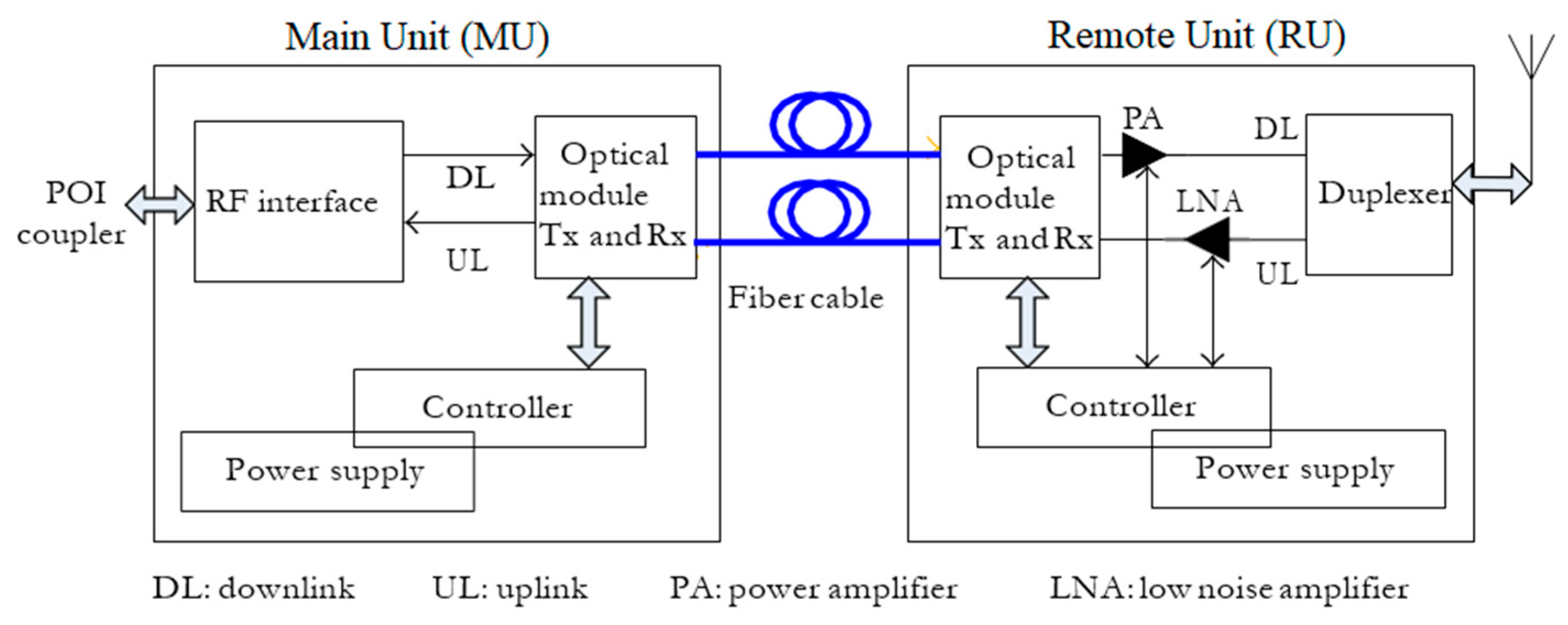



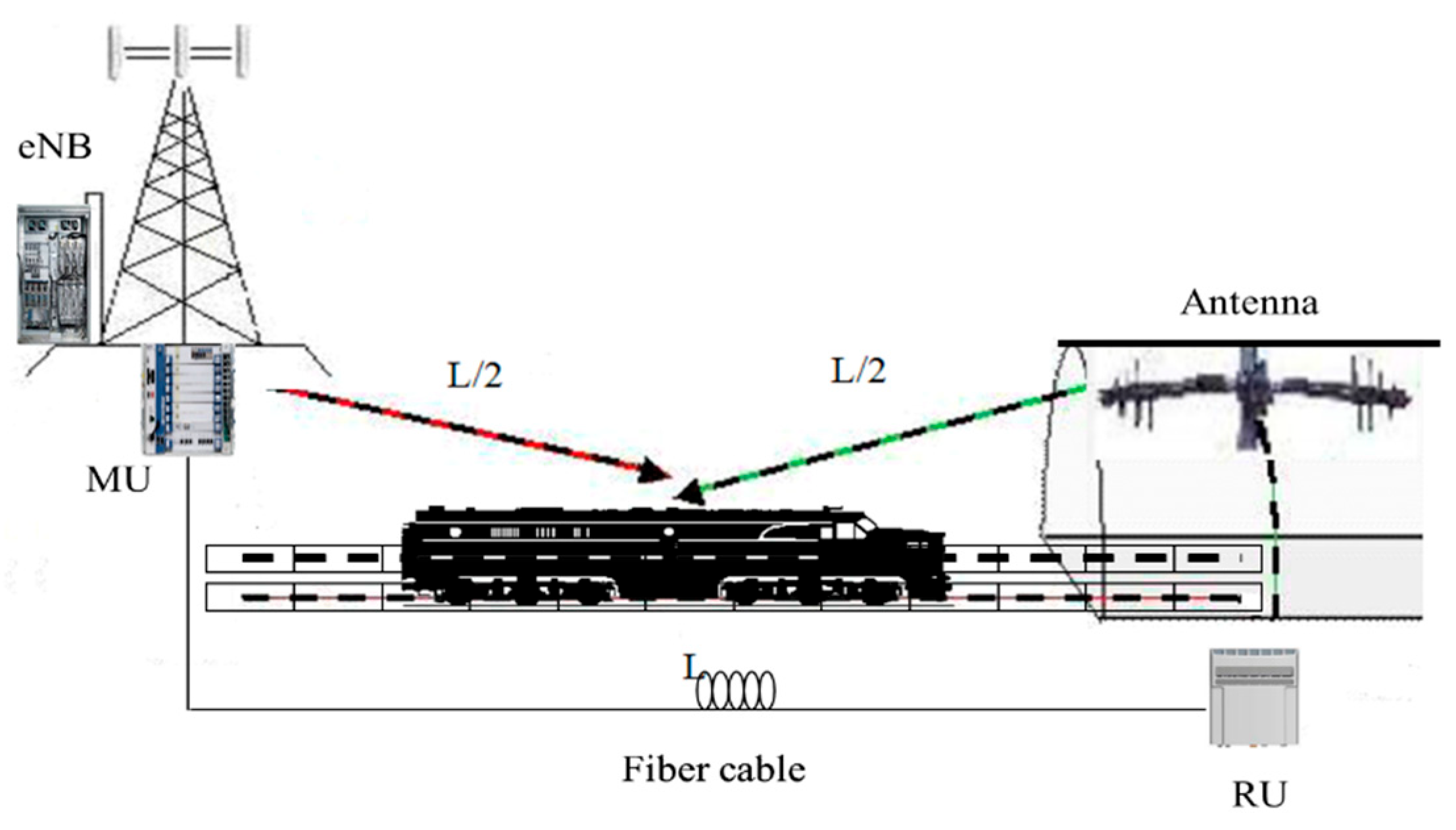



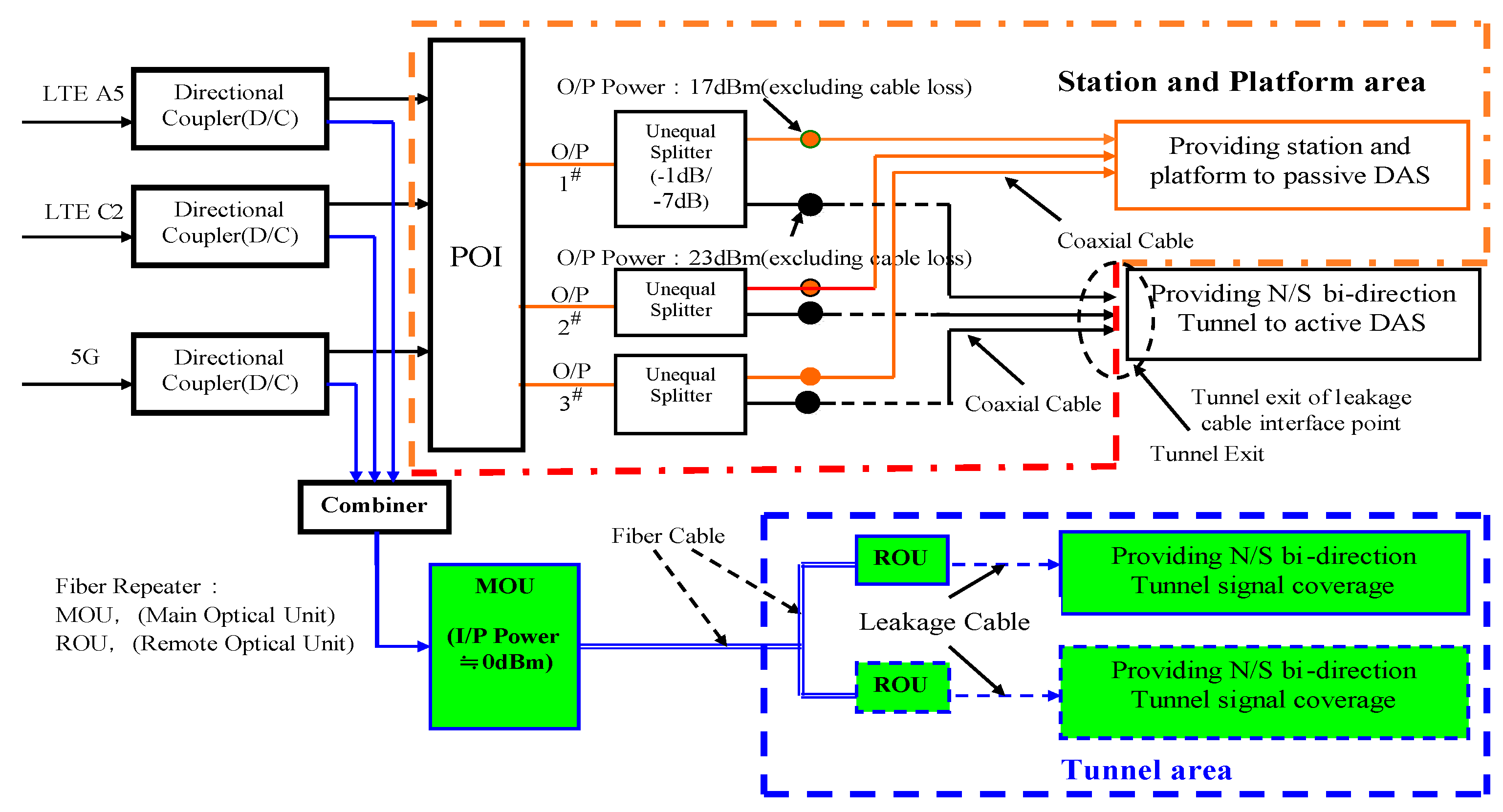

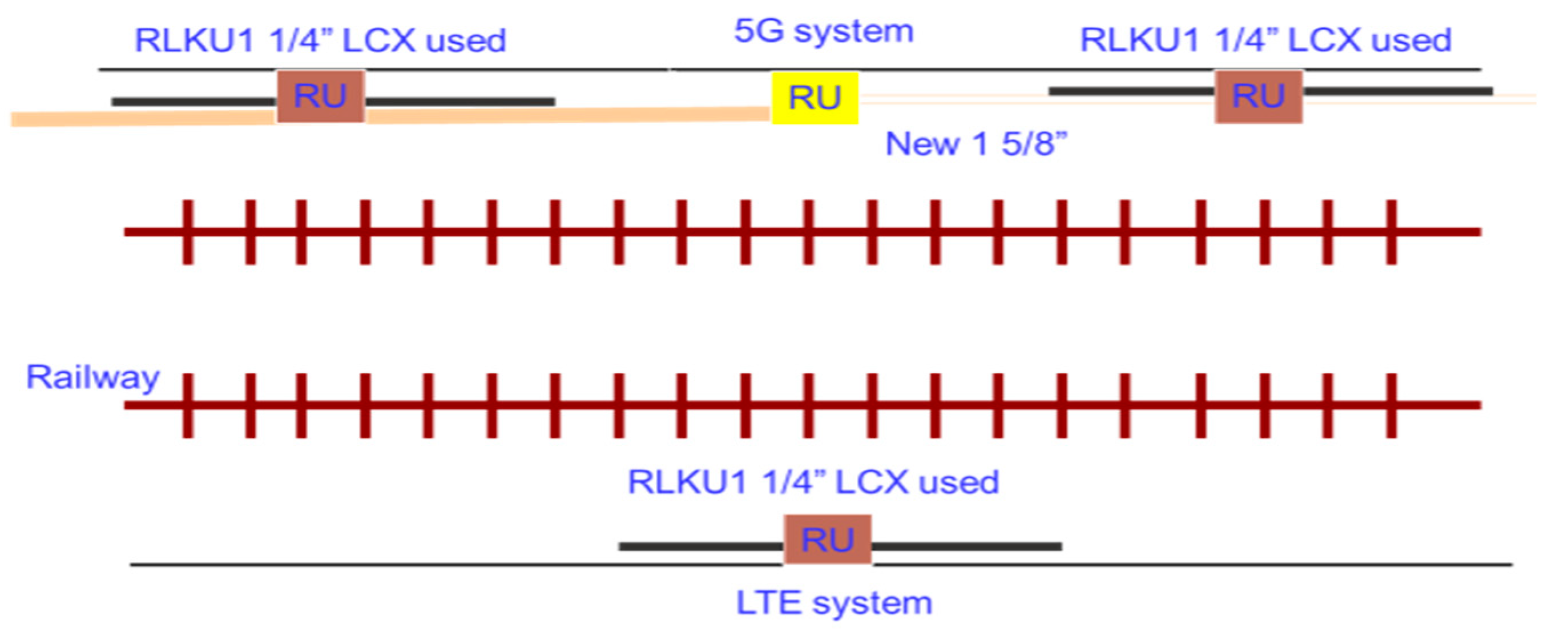

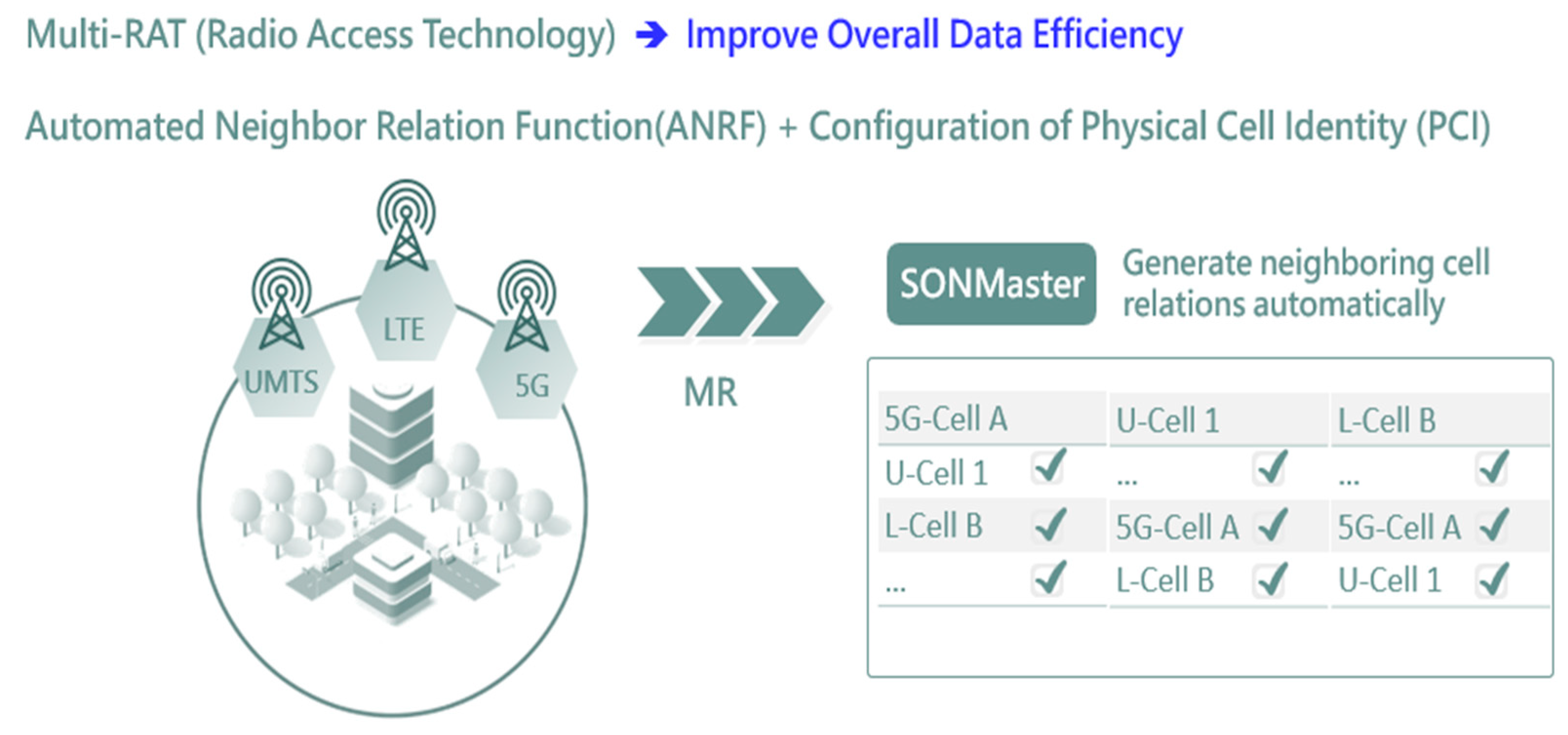

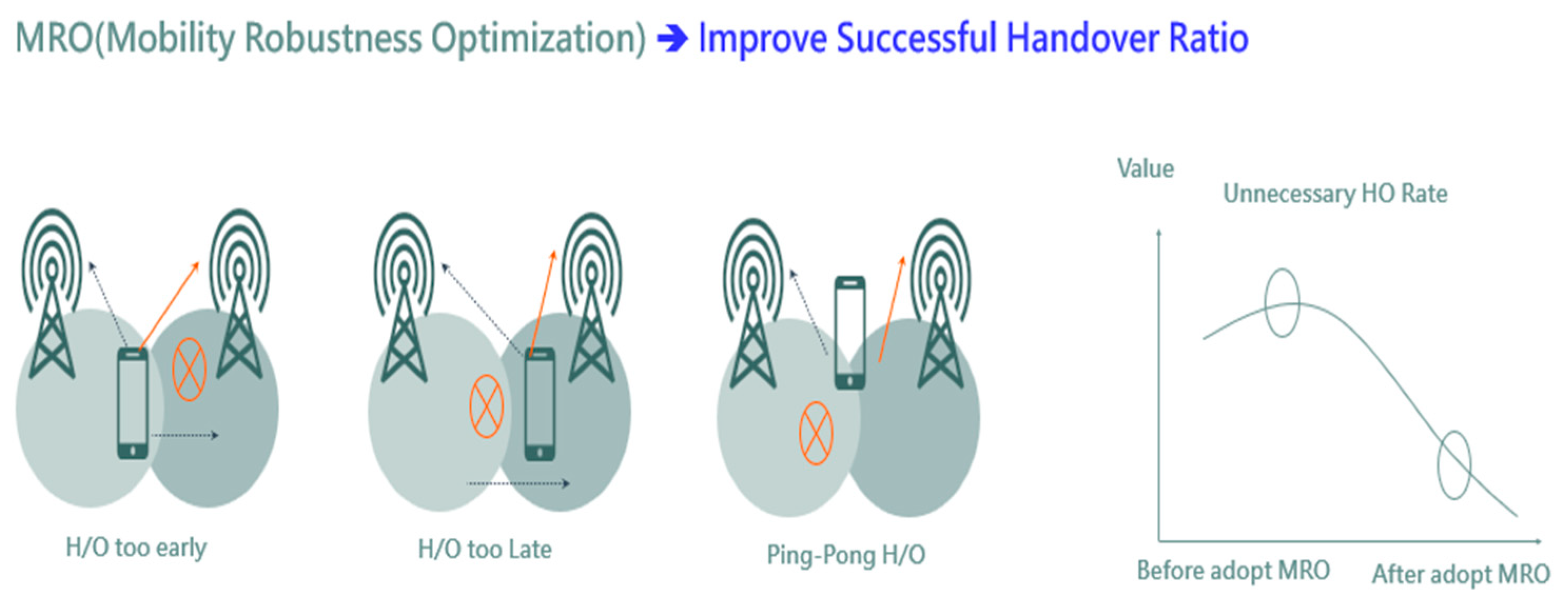

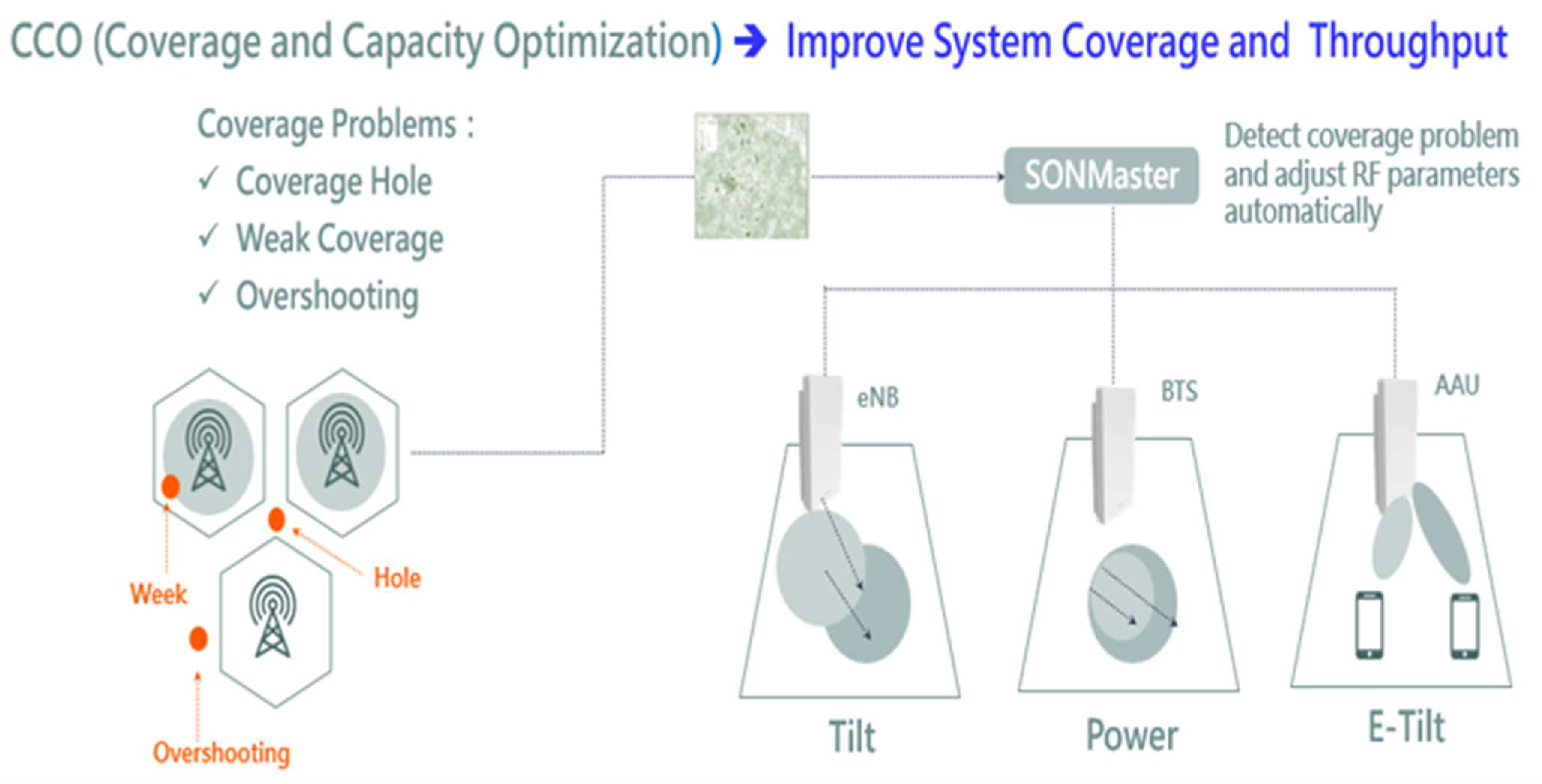
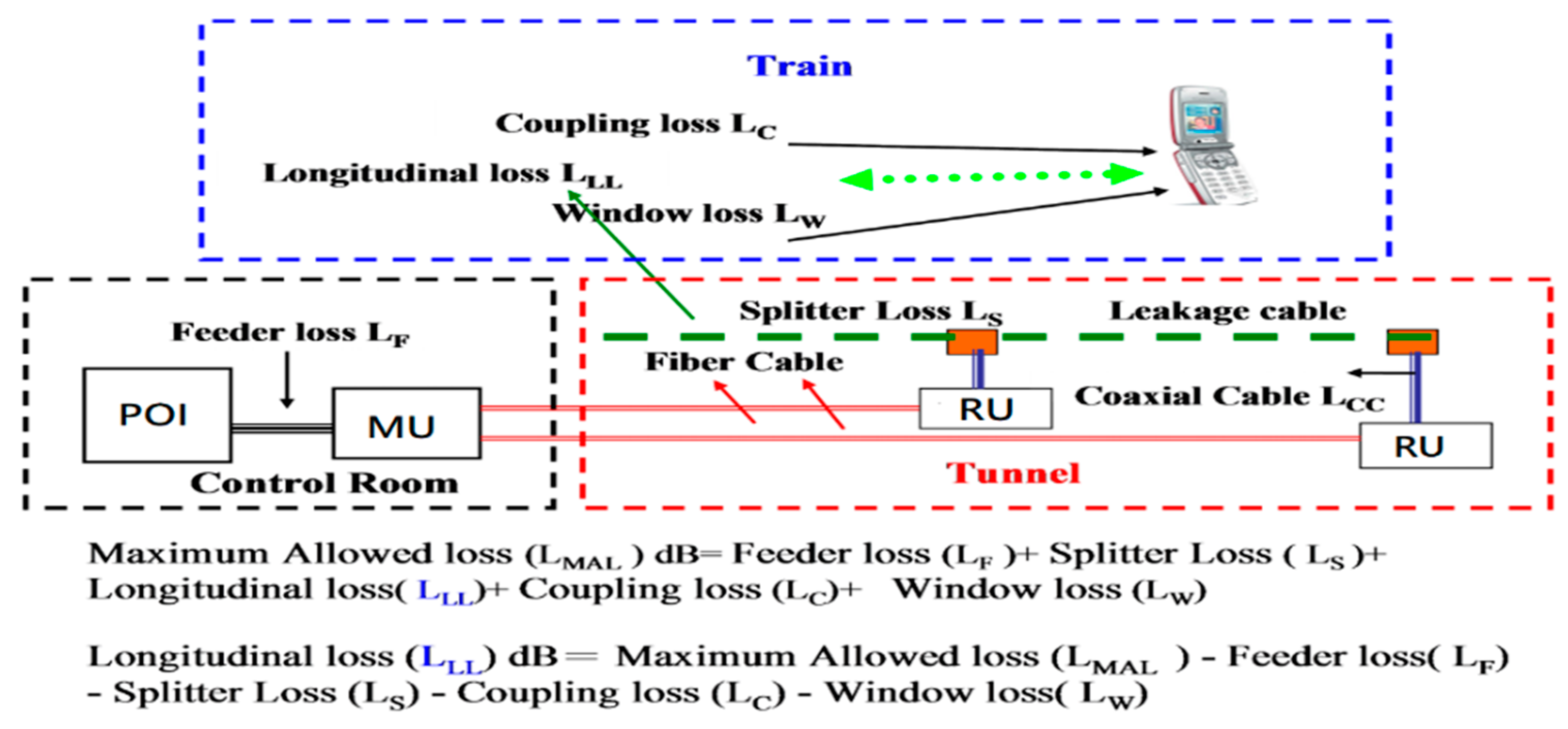


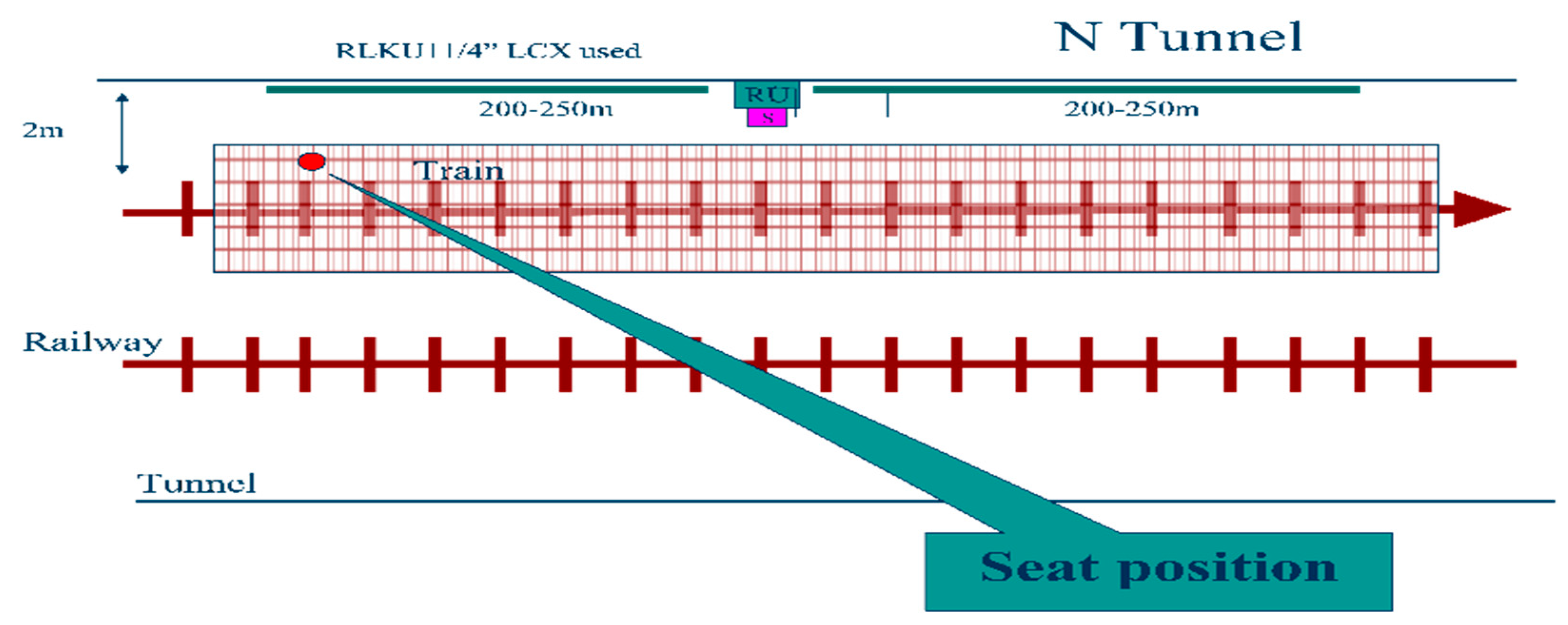


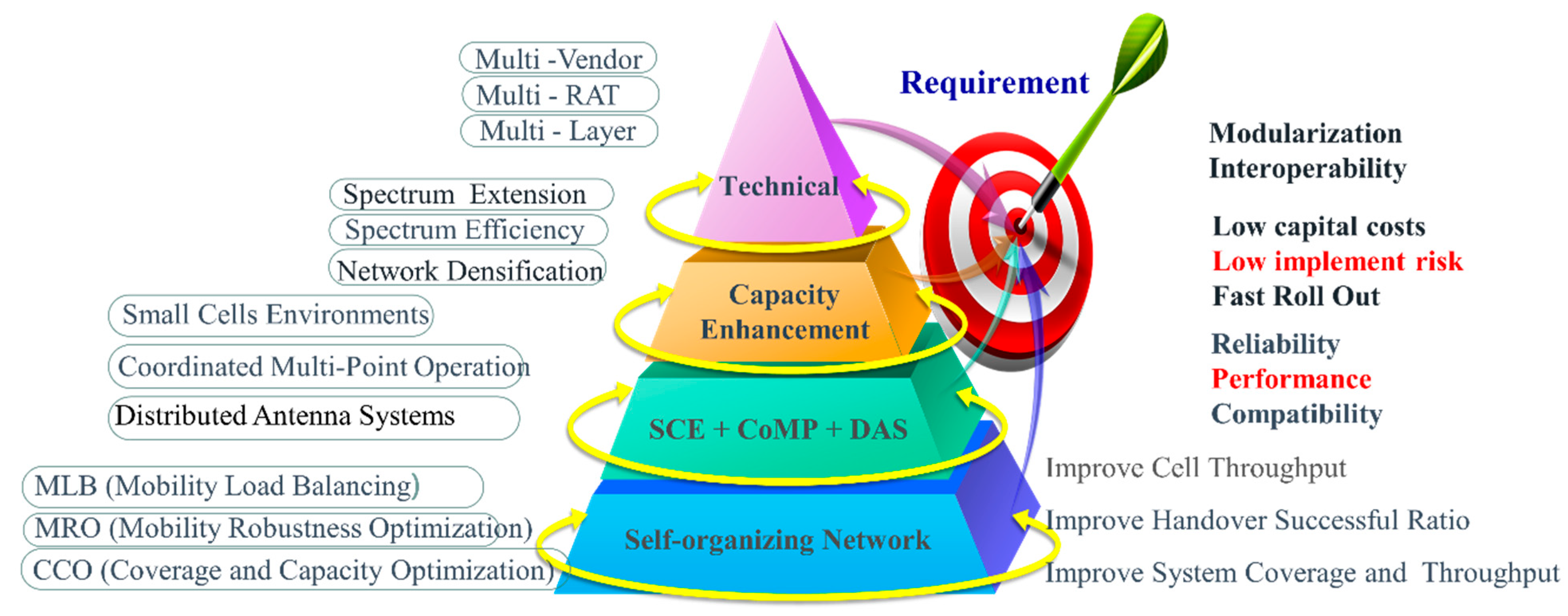
| Solve Problem | ||
|---|---|---|
| The Taiwan Railway Administration (TRA) must install simple and stable systems to improve signal intensity within high buildings and at stations, platforms, and underground tunnels to facilitate integration with and the extension of existing architecture, reserve active and passive equipment space necessary for a next-generation novel system, and improve the quality of the communication network. | ||
| Technologies | Business Requirement | |
| Multi-Radio Access Technology Multi-Layer Multi-Vender | Core Network | Modularization Interoperability |
| Capacity Enhancement (SCE) Spectrum Extension Spectrum Efficiency Network Densification | Radio Access Network | Low capital costs Low implement risk Fast Roll Out |
| Coordinated Multi-Point Architecture Self-organizing Network Small Cells Environment Systems Distributed antenna systems (DAS) | Reliability Performance Compatibility | |
| D2D | Output Power, Po (dBm) | Sensitivity, S (dBm) | Noise Floor, Nmin (dBm) | Signal—Noise Ratio, S/Nmin(dB) | Noise Figure, NF (dB) |
|---|---|---|---|---|---|
| eNB | 44 | −102 | −120 | 9 | 10 |
| cellular phone | 30 | −100 | −121 | 9 | 12 |
| n | PeNB: Thermal Noise Power of eNB Receiver (dB) | |
|---|---|---|
| 2 | −9 | 0.98 |
| 1 | −6 | 1.77 |
| 0 | 0 | 3 |
| ULΔNeNB: = 39 + 2 − 5 + (−9) (dB) | Uplink Grep (dB) |
| 2 | Noise Floor, NFeNB |
| 5 | Noise Floor, NFrep |
| Path Loss, Lp (dB) = Coupling Loss + Cable Loss + Combiner Loss = 39 | Path Loss, Lp (dB) |
| 30 | Coupling Loss |
| 7 | Combiner Loss |
| 2 | Cable Loss |
| ΔNeNB: number of fiber optical repeaters (n) | n |
| −9 | 2 |
| −6 | 1 |
| 0 | 0 |
| Leaking Cable Type | Diameter (mm) | Longitudinal Loss (dB/100 m) | Coupling Loss (dB) | ||
|---|---|---|---|---|---|
| 700 MHz | 2200 MHz | 700 MHz | 2200 MHz | ||
| 1/4″ | 7.5 | 23–32 | 32–52 | 69 | 71 |
| 3/8″ | 9.5 | 12–14 | 18–21 | 68 | 74 |
| 1/2″ | 13.7 | 9.5–11 | 13–18 | 68 | 73 |
| 7/8″ | 24.9 | 5.5–6 | 8–11 | 69 | 72 |
| 1−1/4″ | 36.0 | 2.86–4.5 | 8.15–7.24 | 68 | 71 |
| 1−7/8″ | 46.5 | 2.1 | 4.80–4.87 | 71 | 71 |
| System | Area A | SSreq dBm | Area B | SSreq dBm | Area C | SSreq dBm | Coverage (%) |
|---|---|---|---|---|---|---|---|
| LTE-A | Tunnel, Station, Platform, inbuilding | ≧−80 | Electric escalator, Parking area Shopping mall, Ticket selling area, Information service, Hall, | ≧−85 | Elevator control room, THSR/METRO machine room, toilet, office, exit of tunnel | ≧−85 | 95% |
| 5G | ≧−93 | ≧−92 | ≧−98 | 95% | |||
| LTE-A 5G | ≧−85 | Tunnel and LaBa area | ≧−80 ≧−93 | 97% 90% | |||
| LTE Signal Level with Reference Distance from RU for 11/4″ LCX | 250 m | 200 m | 150 m | 100 m | 50 m | 5 m |
|---|---|---|---|---|---|---|
| Single Train on LCX side (Near side) dBm | −89.4 | −85.3 | −81.2 | −77.2 | −73.1 | −69.4 |
| Single Train on opposite LCX side (Far side) dBm | −97.4 | −93.3 | −89.2 | −85.2 | −81.1 | −77.4 |
| Double Train on opposite LCX side (Far side) dBm | −121.4 | −117.3 | −113.2 | −109.2 | −105.1 | −101.4 |
| LTE Signal Level with Reference Distance from Yagi Antenna for 11/4″ LCX | 5 m | 50 m | 100 m | 150 m | 200 m | 250 m |
| 11dB Yagi Antenna @end of 250 m LCX (Near side) dBm | −67.2 | −87.2 | −93.2 | −96.8 | −99.3 | −101.2 |
| 11 dB Yagi Antenna @end of 200 m LCX (Near side) dBm | −63.1 | −83.1 | −89.1 | −92.7 | −95.2 | −97.1 |
| RSRP Signal Level | Numbers | Percentage | Cumulative | Cumulative Percentage |
|---|---|---|---|---|
| −35 ≤ x | 0 | 0 | 0 | 0 |
| −45 ≤ x ≤ −35 | 127 | 13.5 | 127 | 13.5 |
| −55 ≤ x < −45 | 153 | 29.9 | 280 | 43.4 |
| −65 ≤ x < −55 | 261 | 11.5 | 541 | 54.9 |
| −75 ≤ x < −65 | 353 | 33.8 | 894 | 95.6 |
| −85 ≤ x < −75 | 33 | 2.3 | 927 | 99 |
| −95 ≤ x < −85 | 8 | 0.8 | 935 | 100 |
| −110 ≤ x < −95 | 0 | 0 | 935 | 0 |
| Ec/No Quality Index | Numbers | Percentage | Cumulative | Cumulative Percentage |
| 0 | 0 | 0 | 0 | 0 |
| 1–3 | 114 | 12.1 | 114 | 12.1 |
| 4–6 | 140 | 27.1 | 254 | 39.2 |
| 7–9 | 248 | 14.4 | 502 | 53.6 |
| 10–12 | 390 | 41.8 | 892 | 95.4 |
| 13–15 | 33 | 3.5 | 925 | 98.9 |
| 16–18 | 10 | 1.1 | 935 | 100 |
| 19–21 | 0 | 0 | 935 | 0 |
| RSRP Signal Level | Numbers | Percentage | Cumulative | Cumulative Percentage |
|---|---|---|---|---|
| −35 ≤ x | 0 | 0 | 0 | 0 |
| −45 ≤ x ≤ −35 | 92 | 2.9 | 92 | 2.9 |
| −55 ≤ x < −45 | 321 | 10 | 413 | 12.9 |
| −65 ≤ x < −55 | 730 | 22.8 | 1143 | 35.7 |
| −75 ≤ x < −65 | 1736 | 54.2 | 2879 | 95.9 |
| −85 ≤ x < −75 | 322 | 4 | 3201 | 99.9 |
| −95 ≤ x < −85 | 3 | 0.1 | 3204 | 100 |
| −110 ≤ x < −95 | 0 | 0 | 3204 | 100 |
| Ec/No Quality Index | Numbers | Percentage | Cumulative | Cumulative Percentage |
| 0 | 0 | 0 | 0 | 0 |
| 1–3 | 70 | 2.2 | 70 | 2.2 |
| 4–6 | 359 | 13.4 | 429 | 18.9 |
| 7–9 | 606 | 20.7 | 1035 | 32.3 |
| 10–12 | 2060 | 64.3 | 3095 | 96.6 |
| 13–15 | 105 | 3.3 | 3200 | 99.9 |
| 16–18 | 4 | 0.1 | 3204 | 100 |
| 19–21 | 0 | 0 | 3204 | 100 |
Disclaimer/Publisher’s Note: The statements, opinions and data contained in all publications are solely those of the individual author(s) and contributor(s) and not of MDPI and/or the editor(s). MDPI and/or the editor(s) disclaim responsibility for any injury to people or property resulting from any ideas, methods, instructions or products referred to in the content. |
© 2023 by the authors. Licensee MDPI, Basel, Switzerland. This article is an open access article distributed under the terms and conditions of the Creative Commons Attribution (CC BY) license (https://creativecommons.org/licenses/by/4.0/).
Share and Cite
Wu, C.-L.; Lu, T.-T.; Lee, C.-T.; Sun, J.-S.; Lin, H.-P.; Hwang, Y.-S.; Sung, W.-T. Evolution towards Coordinated Multi-Point Architecture in Self-Organizing Networks for Small Cell Enhancement Systems. Electronics 2023, 12, 2473. https://doi.org/10.3390/electronics12112473
Wu C-L, Lu T-T, Lee C-T, Sun J-S, Lin H-P, Hwang Y-S, Sung W-T. Evolution towards Coordinated Multi-Point Architecture in Self-Organizing Networks for Small Cell Enhancement Systems. Electronics. 2023; 12(11):2473. https://doi.org/10.3390/electronics12112473
Chicago/Turabian StyleWu, Chia-Lun, Tsung-Tao Lu, Chin-Tan Lee, Jwo-Shiun Sun, Hsin-Piao Lin, Yuh-Shyan Hwang, and Wen-Tsai Sung. 2023. "Evolution towards Coordinated Multi-Point Architecture in Self-Organizing Networks for Small Cell Enhancement Systems" Electronics 12, no. 11: 2473. https://doi.org/10.3390/electronics12112473
APA StyleWu, C.-L., Lu, T.-T., Lee, C.-T., Sun, J.-S., Lin, H.-P., Hwang, Y.-S., & Sung, W.-T. (2023). Evolution towards Coordinated Multi-Point Architecture in Self-Organizing Networks for Small Cell Enhancement Systems. Electronics, 12(11), 2473. https://doi.org/10.3390/electronics12112473








